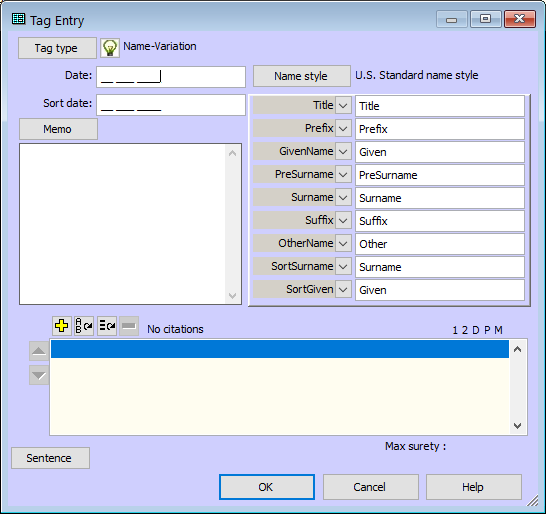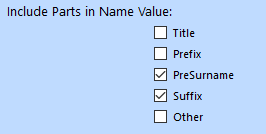Overview
The Names section includes properties related to TMG name records.
Properties
Always Export Primary Name
When Always Export Primary Name is checked, which is the default, TMG to GEDCOM will export the primary name even if that name's Tag Type is not exported via the Tags Section.
When Always Export Primary Name is unchecked, TMG to GEDCOM will not export the primary name if that name's Tag Type is not exported via the Tags Section.
Primary Tag Sequence
The Primary Tag Sequence property determines whether primary names are written before or after non-primary names in the GEDCOM file. The default value is "Before non-primary (first)".
The GEDCOM specificaton mandates that when there are two or more tags at the same level the first tag should be deemed the "most credible", known as "primary" in the terminology of TMG and TMG to GEDCOM. Some GEDCOM readers do not conform to the standard when reading NAME tags and they treat the last alternative as primary. To accommodate those non-compliant programs, TMG to GEDCOM provides an option to write the primary variation last.
Include Primary Indicators
The Include Primary Indicators property determines whether TMG to GEDCOM includes a custom record to indicate the primary name record for a person. The default value is unchecked.
Most programs determine which name is primary (also called preferred) based on the sequence of the name records, as described above.
PreSurname in Surname
When PreSurname in Surname is checked, which is the default, a value in TMG's PreSurname name part is included in the surname section of the "combined name" GEDCOM record.
Example:
Assume you have a person with these name parts in TMG:
- Given: Vincent
- PreSurname: van
- Surname: Gogh
When PreSurname in Surname is checked, TMG to GEDCOM will write these GEDCOM records:
1 NAME Vincent /van Gogh/ 2 GIVN Vincent 2 SPFX van 2 SURN Gogh
When PreSurname in Surname is unchecked, TMG to GEDCOM will write these GEDCOM records:
1 NAME Vincent van /Gogh/ 2 GIVN Vincent 2 SPFX van 2 SURN Gogh
Suffix Comma (Name)
The Suffix Comma (Name) property determines whether TMG to GEDCOM inserts a leading comma before the suffix value when exporting the GEDCOM NAME record.
The Suffix Comma (Name) choices are:
- Insert leading comma – Inserts a leading comma and space prior to exporting the Suffix. Will not add a comma and space if the Suffix field of the TMG name record starts with a comma.
- Leave as is – Exports the Suffix field of the TMG name record without modifying it. This is the default.
- Remove leading comma – Removes a leading comma if present, or comma and space if present, from the Suffix field of the TMG name record. prior to exporting the Suffix.
Which choice is appropriate depends on how you have entered suffixes in TMG and what the GEDCOM reader expects on the GEDCOM NAME record.
See the Suffix Comma section below.
Suffix Comma (Part)
The Suffix Comma (Part) property determines whether TMG to GEDCOM inserts a leading comma before the suffix value when exporting the GEDCOM NSFX record.
The Suffix Comma (Part) choices are the same as the Suffix Comma (Name) choices above. The default value is "Leave as is".
Which choice is appropriate depends on how you have entered suffixes in TMG and what the GEDCOM reader expects on the GEDCOM NSFX record.
See the Suffix Comma section below.
Use Pronoun for Subject
The Use Pronoun for Subject property determines whether a pronoun replaces the subject's name when formatting the Note Value or Text Value. The default is unchecked, and the subject's full name will appear when rendered with variables that are eligible to be converted to a pronoun, such as [S].
When Use Pronoun for Subject is checked, some references to the subject's full name will be replaced with a pronoun. There are several restrictions:
- The variable must refer to the subject, the person whose GEDCOM records are being written.
- The variable must be creating the first output of the sentence template.
- The variable must be a full name variable.
Variables that yield the first name or some other subset of the name are not eligible.
- The variable must not include an option that requires the full name to be rendered, such as
[S+]or[P+].
Suffix Comma
TMG to GEDCOM includes two properties for controlling the value of suffixes exported to the GEDCOM file, Suffix Comma (Name) and Suffix Comma (Part). There are two properties because GEDCOM files include the suffix value in two places.
The suffix appears in the NAME record where all the name parts are present:
1 NAME John /Doe/ Jr
The suffix also appears in the NSFX (name-suffix) record which has only the suffix part of the name:
2 NSFX Jr
If the two Suffix Comma properties are set to the default "Leave as is" value, the full set of name-related records for "John Doe Jr" would be:
1 NAME John /Doe/ Jr 2 GIVN John 2 SURN Doe 2 NSFX Jr
Some people include a leading comma in the Suffix part of the TMG Name record, and if that comma is present, the GEDCOM name-related records would be:
1 NAME John /Doe/, Jr 2 GIVN John 2 SURN Doe 2 NSFX , Jr
The program that imports the GEDCOM file may or may not expect a comma in the value. The GEDCOM specification does not show a comma and does not indicate whether such punctuation should be included or not. To get the results you want from the GEDCOM reader, you might have to add or remove a leading comma from one or both of the GEDCOM suffix values.
The Suffix Comma (Name) property affects the first version of the suffix, the one that appears in the NAME record:
1 NAME John /Doe/ Jr
The Suffix Comma (Part) property affects the second version of the suffix, the one that appears in the NSFX (name-suffix) record:
2 NSFX Jr
Name Parts in the Name Record
The Include Parts in Name Value subsection determines which TMG name parts are included in the GEDCOM NAME record. By default, TMG to GEDCOM includes all TMG name parts in the GEDCOM NAME record, but some GEDCOM readers expect only a subset of the name pieces in the GEDCOM NAME record. To omit a TMG place part from the GEDCOM NAME record, uncheck the corresponding property.
Here is an example of a TMG name where all the name parts have a value:

By default, TMG to GEDCOM will include all name parts in the GEDCOM NAME record:
1 NAME Title, Prefix Given /PreSurname Surname/ Suffix (Other) 2 NPFX Title, Prefix 2 GIVN Given 2 SPFX PreSurname 2 SURN Surname 2 NSFX Suffix (Other)
If you uncheck the Title, Prefix, and Other options:

That changes how TMG to GEDCOM writes the GEDCOM NAME record:
1 NAME Given /PreSurname Surname/ Suffix 2 NPFX Title, Prefix 2 GIVN Given 2 SPFX PreSurname 2 SURN Surname 2 NSFX Suffix (Other)
All the part values are exported via GEDCOM's "name piece" subrecords, but the GEDCOM NAME record includes only a subset of the TMG name parts.
Parts and Pieces
TMG name records include up to nine parts. The GEDCOM 5.5.1 specification splits names into six name pieces.
| TMG Part |
GEDCOM Name Piece |
|---|---|
| Title | |
| Prefix | NPFX |
| GivenName | GIVN |
| NICK | |
| PreSurname | SPFX |
| Surname | SURN |
| Suffix | NSFX |
| Other | |
| SortSurname | |
| SortGiven |
If you use custom name styles, the TMG part names may be different than shown above. The actual part labels do not affect the processing logic described below.
With the mismatch between TMG name parts and GEDCOM name pieces, exporting some names involves creative use of the GEDCOM name piece values.
- TMG to GEDCOM does not export the SortSurname and SortGiven name parts. GEDCOM has no logical name pieces for them, and other programs do not support the concept of name parts dedicated to sorting.
- If a TMG name includes a Title part or a Prefix part but not both, TMG to GEDCOM exports the part using the GEDCOM
NPFXrecord.If a TMG name includes both a Title part and a Prefix part, TMG to GEDCOM concatenates the parts using a comma and space delimiter, "title, prefix", and exports the value using the GEDCOM
NPFXrecord. - TMG to GEDCOM wraps TMG's Other part in parentheses before exporting it, i.e., "(other)".
- If a TMG name includes a Suffix part or an Other part but not both, TMG to GEDCOM exports the part using the GEDCOM
NSFXrecord.If a TMG name includes both a Suffix part and an Other part, TMG to GEDCOM concatenates the parts using a space delimiter, "suffix (other)", and exports the value using the GEDCOM
NSFXrecord. - TMG to GEDCOM does not use GEDCOM's
NICKrecord.